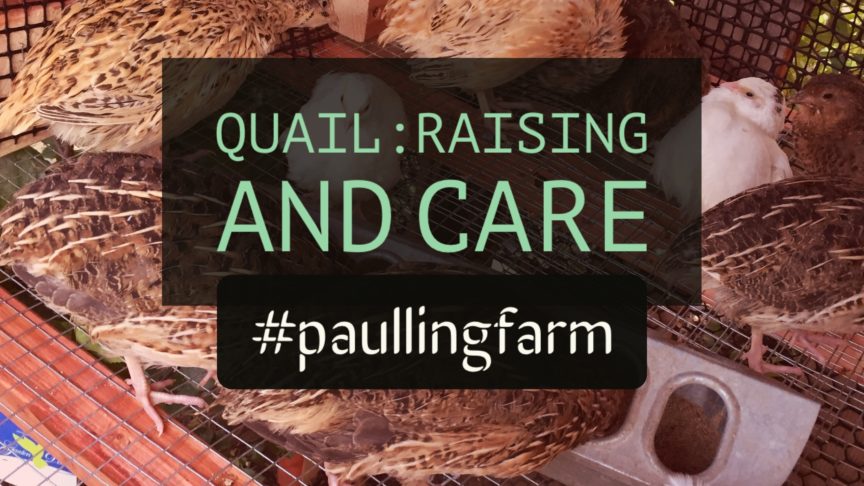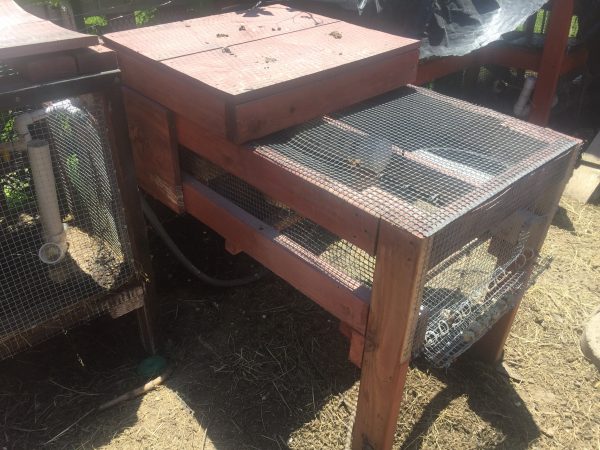


Igot into quail kind of by accident. I was visiting a small farm I found on facebook in the Dallas area to buy some chickens (We lost 4 to a raccoon) and they had a ton of other animals as well. Ducks, geese, pheasant, and tons of quail. So I was naturally curious, because I love all animals, and was given a ton of information about the little guys. So I wanted to share some of that with you. In case you'd also like to get some quail.First of all, they are super easy to care for. Easier than chickens. You really just have to make sure they have access to food and water all the time and keep them clean. Some online folk say you can keep them inside like other pet birds, which is fine for small numbers, but they do have very strong poop smell. Ammonia builds up. I’d recommend keeping them outside.
Space Requirements : Each bird needs somewhere in the range of 0.5 to 1.0 square feet of space in wire-floored environment. Which is pretty small. Its also recommended that you have about five hens per rooster. As that ratio diminishes (4:1, 3:1) more fighting among roosters will occur, and it can get very violent. Many of the birds have had to be separated into a recovery pen to let wounds heal. I started with too many roosters. (this problem has been resolved by eating the most aggressive ones first)
Quail Eggs and Nutrition
Quail Eggs have:- 5x the iron & potassium of chicken eggs
- Tons of Calcium and Protein
- A & B vitamins
- No “bad” cholesterol
- High in “good” cholesterol
- Do not trigger egg allergies
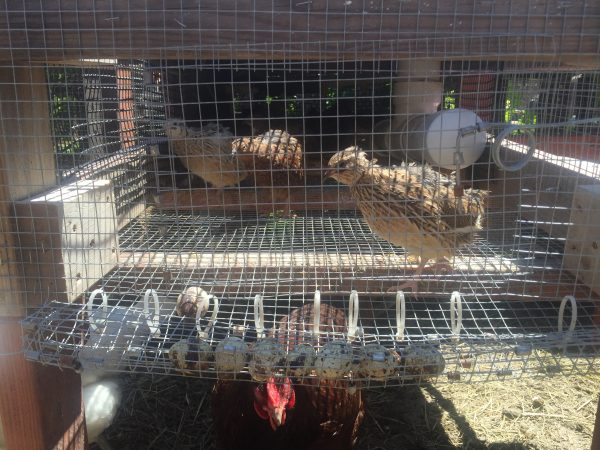


What to Expect from Quail
Quail have a short lifespan. (around 3 years) so hatching eggs might be something you want to consider. Its very easy.
Quail become adults at 6 weeks and start laying shortly after that (7-8 weeks old) which is insanely fast. Chickens dont start laying till about 6 months, so the turn around is much faster.
One quail can lay about 300 eggs a year. Almost one a day. They are also much smaller than chicken eggs, so you need about 4 quail eggs to have the same substance of 1 chicken egg, even though they are much higher quality in terms of nutrition. My wife and I mix them in with chicken eggs so we dont have to crack 25 eggs to make an omelet. We also love to fry them up with some butter and pepper and have bite sized pops. Ill do another article on recipes soon.
Coturnix quail are very hardy, and likely don’t need supplemental heating during the winter, but I went ahead and bought a 100w infrared ceramic heater that simply plugs into a light socket and hangs from the roof. (You can see it in the top picture inside the back of the cage. It’s black.)
You will have lower cost of feed than you would with chickens. You do need to make sure you buy a feed that has a higher level of protein content. (~25%). Normal chicken feed is less than that, so your quail will stop laying eggs with that, so I buy “chicken starter” which is a high protein feed for baby chickens that helps them grow. Quail will also eat small bugs, mealworms, and greens from the garden.
You can keep quail even if your city or HOA doesn’t allow chickens. They are not considered poultry (Note: I am not a lawyer. I just read.) and instead are considered game birds and don’t get limited in the same way. They are much quieter (except for some over eager roosters, but even they are still not that bad) and none of my neighbors even know we have them.
Quail do not roost, and will not use roosts, so building them is a waste of time. In fact, quail are flighty when scared, and they can take off so fast that they can break their own necks if allowed to reach flight speed by hitting the hard ceiling. Most cage builders recommend keeping the height of your cage 12″-18″ tall to limit upward mobility.
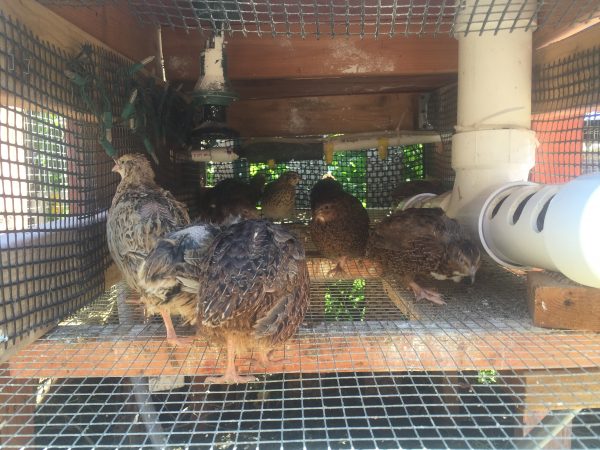


Inside the quail pen.
As you can see in the top picture, my quail pen is about 3 feet wide and 6 feet deep, and at any one time I have about 15 quail in there. The back half is completely covered with sealed wood, to protect them from heavy rain and keep their food dry, and the front half has plastic 1/4″ mesh for ventilation and seeing out.
In the back is a small ceramic heater that I use during the winter. Its connected to an outdoor light socket.
I build the pen square, but then dug the front posts down so that the whole thing slopes forward. (about 1″ per 1′). This allows all the eggs to roll forward slowly and become trapped at the front. In the above picture, you see the egg trap, which has a flap over the top to prevent the chickens from grabbing them (because they will eat them) and the zip ties allow eggs to pass through but not quail (because I had a problem with some of the quail squeezing out under the egg gap)
The feeder is a 3″ pvc T shape that extends to the top of the pen (for maximum holding of food) and then T’s off and has small holes drilled in the side about 45 degrees off vertical. Quail are VERY messy eaters and will waste more food than they eat if they are allowed to claw in the food. They like to dig, so they think they are getting down into the food, when they really are just wasting it. I have an open area under my pen where the chickens can clean up any wasted food, and they love it since it gives them something to do and they love the higher protein stuff.
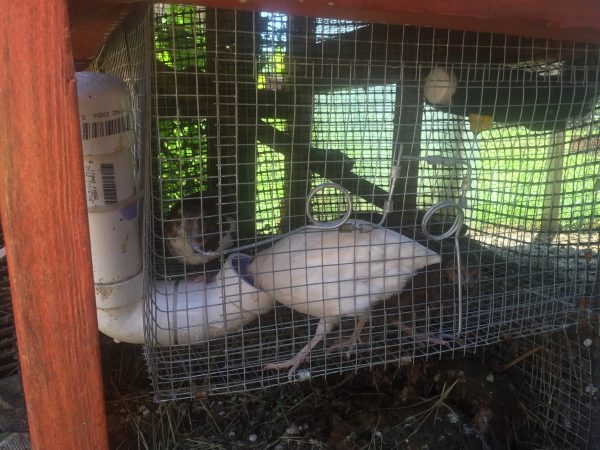


Separate grow out pen for adolescents.
My watering system for them is the connected to the same system as everything else. One big barrel is located up high, and then a 3/4″ pvc pipe runs throughout the pens for the chickens, rabbits, and quail and is distributed via those yellow plastic nipples. I highly recommend them.
I also have a string of christmas lights inside the pen, as well as one in the chicken coop, that I turn on in the winter to prolong the egg laying season. You need about 15 hours of light to trigger egg production in poultry, and when winter hits, you need a few extra hours. These lights are connected to a timer.
Quail also LOVE a good dust bath. I occasionally put a pan of Diatomaceous Earth in with them and they will roll around in it for hours.
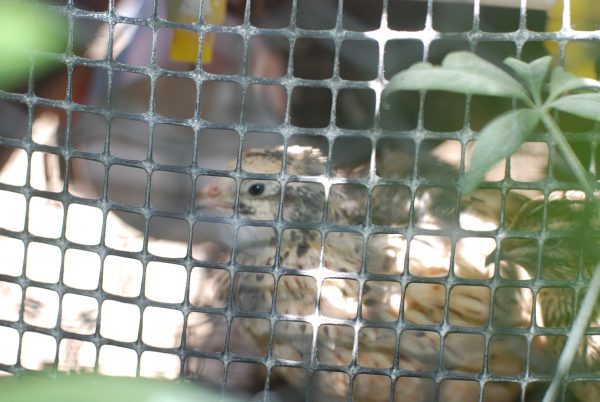


Parts featured in this article:
Support us on Patreon!
I hope you've enjoyed this tutorial! Please consider donating on our Patreon page! The more money we raise, the bigger and more elaborate project tutorials we can do for you!
Check out the Patreon Page
